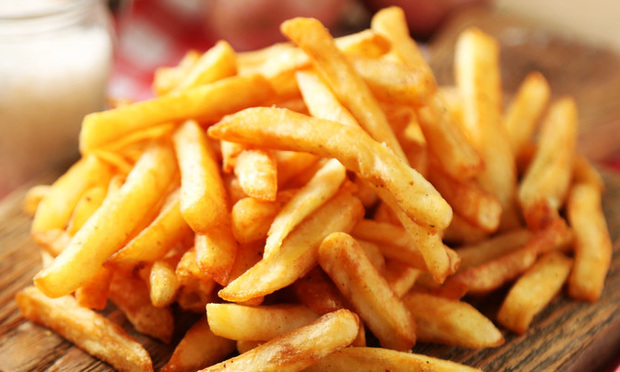Daily Dicta: Why Won't the FDA Tell Us What Foods Are Risky?
"Congress required this done years ago, with good reason,' said a lawyer from the Center for Food Safety, which has sued the FDA to force action.
October 18, 2018 at 01:48 PM
6 minute read
 Here's a fun fact about me: My grandfather co-invented Cheez-Whiz. And McDonalds french fries.
Here's a fun fact about me: My grandfather co-invented Cheez-Whiz. And McDonalds french fries.
(Seriously. This is his 2007 obituary.)
So when I saw that the Center for Food Safety and the Center for Environmental Health jointly sued the U.S. Food and Drug Administration demanding that the agency identify “high risk” foods, I thought immediately of Grandpa Ed's legacy.
It turns out, the foods they're talking about aren't the ones that will kill you slowly (i.e. a steady diet of french fries and Cheez Whiz) but rather those most associated with foodborne illnesses.
According to The Centers for Disease Control and Prevention, 48 million people—that's one in six Americans—get sick every year from food poisoning, 128,000 are hospitalized and 3,000 die.
Under the Food Safety Modernization Act of 2010, the FDA was supposed to designate foods with a high risk of carrying foodborne illnesses by January 2012, and to propose record-keeping requirements for facilities that handle those foods by January 2013.
 It strikes me as a basic good government move to protect public health. I don't know about you, but I'd like to do everything I can to avoid vomiting, bloody diarrhea or perhaps cascading organ failure.
It strikes me as a basic good government move to protect public health. I don't know about you, but I'd like to do everything I can to avoid vomiting, bloody diarrhea or perhaps cascading organ failure.
But five years after the deadline, the FDA has yet to identify a single high-risk food.
“As the continued foodborne illness epidemic in our country shows, there is an urgent need to designate high-risk foods and establish their reporting requirements so that our government can rapidly and effectively respond to outbreaks,” said Ryan Talbott, a Center for Food Safety staff attorney. ”Congress required this done years ago, with good reason. As we have in the past, we will continue to hold FDA accountable to protect public health.”
The 24-page complaint filed in U.S. District Court for the Northern District of California claims the agency has violated the Administrative Procedure Act by failing to act, and seeks declaratory and injunctive relief.
“Without a list of designated high-risk foods that is accessible to the public through FDA's website and the additional reporting requirements to 'rapidly and effectively' track and trace these foods … Congress's will is thwarted and plaintiffs' members are deprived of information that they otherwise would have,” the complaint states.
So far, the FDA has only managed to solicit public comments on its “draft approach for the review and evaluation of data to designate high-risk foods” in 2014. That involved explaining the methods under consideration and asking for feedback—a step which wasn't even required by the statute.
The complaint doesn't speculate why the FDA under both Democrat and Republican administrations has dragged its feet about naming high-risk foods.
Presumably it's not that the agency is pro-food poisoning. But it's easy to imagine that there has been fierce lobbying around the designation. After all, if you were a cantaloupe grower or a company that produced packaged salads, would you want your product to be labeled “high-risk”? And to assume more burdensome tracking and reporting obligations?
I'm pretty sure the answer is somewhere between no and hell no.
An obvious way to identify candidates for the high-risk designation is to look at recent food poisoning outbreaks.
Among the examples cited in the complaint are chicken (Salmonella Heidelberg); pomegranates (Hepatitis-A); cucumbers (Salmonella Newport); cilantro (Cyclospora); prepackaged caramel apples (Listeriosis); ice cream (Listeriosis); frozen vegetables (Listeriosis); papaya (Salmonella); chicken salad (Salmonella Typhimurium) and romaine lettuce (E. coli).
Yikes.
So what's safe to eat? Besides Cheez Whiz and french fries, that is?
One of my favorite sources is Bill Marler, a name partner at food poisoning boutique Marler Clark in Seattle. He does nothing but litigate food poisoning cases—and as a result, he says he avoids sprouts, raw milk, unpasteurized juices, raw oysters and bagged salads, and is leery of ground beef and chicken.
But here's what he once told me he does eat: “I'll bend towards ordering a pizza at a restaurant. The chances of a pizza killing you—pretty low.”
News you can use. You're welcome.
What I'm Reading
Fourth Circ. Nominee Allison Rushing Defends Experience Before Senators
This question from a Republican senator, asking what her Williams & Connolly colleagues might be wondering as well: “I think to be a really good federal judge you've gotta have some life experience … Tell me why you're more qualified to be on the Fourth Circuit than some of the Williams & Connolly [lawyers] that have been there for 20 years, 25, 30 years in the trenches?”
K&L Gates Hit with $100M Malpractice Suit in Texas
“Predatory lenders prey on financial difficulties. A predatory law firm can prey on the concept of justice itself,” says the complaint, which seeks $100 million in punitive damages.
Qualcomm Asks 9th Circuit to Intervene in $5B Class Action
The company says U.S. District Judge Lucy Koh in certifying a massive antitrust class action last month committed multiple errors, including depriving Qualcomm of a hearing.
Trump Foundation Lawyers to Argue Political Bias Taints NY AG's Lawsuit
Trump Foundation lawyer Alan Futerfas argues that former Attorney General Eric Schneiderman should not have been allowed to investigate the Trump Foundation while simultaneously soliciting campaign donations based on his opposition to Trump.
Insurance Giant Hit With Class Action Alleging Underpayment for Mental Health Visits
Affiliates of UnitedHealth Group Inc., the nation's largest health insurer, were sued by lawyers at Zuckerman Spaeder for allegedly underpaying reimbursements for mental health services.
John Roberts Talks Kavanaugh, the Court's Shrinking Docket and 'Legally Blonde'
When a new justice arrives, Roberts mused, “the eight who were there before behave themselves better. It's really like having a new in-law at Thanksgiving dinner. You know, Uncle Fred will put on a clean shirt.”
In case you missed it…
Daily Dicta: Faegre Baker Daniels Connection Helps Sink Mary Bono as USA Gymnastics CEO
It's entirely possible that Bono never even met the former Faegre litigator who represented USA Gymnastics as the Larry Nassar sex abuse scandal was unfolding.
This content has been archived. It is available through our partners, LexisNexis® and Bloomberg Law.
To view this content, please continue to their sites.
Not a Lexis Subscriber?
Subscribe Now
Not a Bloomberg Law Subscriber?
Subscribe Now
NOT FOR REPRINT
© 2025 ALM Global, LLC, All Rights Reserved. Request academic re-use from www.copyright.com. All other uses, submit a request to [email protected]. For more information visit Asset & Logo Licensing.
You Might Like
View All
Litigator of the Week: A Long-Sought Win on Preemption for Monsanto at the Third Circuit

Litigators of the Week: Proskauer Scores a Defense Win for Last Defendant Standing in Broiler Chicken Antitrust Suit

Litigators of the Week: Covington Team Gets a Directed Verdict in First Trial Over Heavy Metals in Baby Food
Trending Stories
- 1'A Death Sentence for TikTok'?: Litigators and Experts Weigh Impact of Potential Ban on Creators and Data Privacy
- 2Bribery Case Against Former Lt. Gov. Brian Benjamin Is Dropped
- 3‘Extremely Disturbing’: AI Firms Face Class Action by ‘Taskers’ Exposed to Traumatic Content
- 4State Appeals Court Revives BraunHagey Lawsuit Alleging $4.2M Unlawful Wire to China
- 5Invoking Trump, AG Bonta Reminds Lawyers of Duties to Noncitizens in Plea Dealing
Who Got The Work
J. Brugh Lower of Gibbons has entered an appearance for industrial equipment supplier Devco Corporation in a pending trademark infringement lawsuit. The suit, accusing the defendant of selling knock-off Graco products, was filed Dec. 18 in New Jersey District Court by Rivkin Radler on behalf of Graco Inc. and Graco Minnesota. The case, assigned to U.S. District Judge Zahid N. Quraishi, is 3:24-cv-11294, Graco Inc. et al v. Devco Corporation.
Who Got The Work
Rebecca Maller-Stein and Kent A. Yalowitz of Arnold & Porter Kaye Scholer have entered their appearances for Hanaco Venture Capital and its executives, Lior Prosor and David Frankel, in a pending securities lawsuit. The action, filed on Dec. 24 in New York Southern District Court by Zell, Aron & Co. on behalf of Goldeneye Advisors, accuses the defendants of negligently and fraudulently managing the plaintiff's $1 million investment. The case, assigned to U.S. District Judge Vernon S. Broderick, is 1:24-cv-09918, Goldeneye Advisors, LLC v. Hanaco Venture Capital, Ltd. et al.
Who Got The Work
Attorneys from A&O Shearman has stepped in as defense counsel for Toronto-Dominion Bank and other defendants in a pending securities class action. The suit, filed Dec. 11 in New York Southern District Court by Bleichmar Fonti & Auld, accuses the defendants of concealing the bank's 'pervasive' deficiencies in regards to its compliance with the Bank Secrecy Act and the quality of its anti-money laundering controls. The case, assigned to U.S. District Judge Arun Subramanian, is 1:24-cv-09445, Gonzalez v. The Toronto-Dominion Bank et al.
Who Got The Work
Crown Castle International, a Pennsylvania company providing shared communications infrastructure, has turned to Luke D. Wolf of Gordon Rees Scully Mansukhani to fend off a pending breach-of-contract lawsuit. The court action, filed Nov. 25 in Michigan Eastern District Court by Hooper Hathaway PC on behalf of The Town Residences LLC, accuses Crown Castle of failing to transfer approximately $30,000 in utility payments from T-Mobile in breach of a roof-top lease and assignment agreement. The case, assigned to U.S. District Judge Susan K. Declercq, is 2:24-cv-13131, The Town Residences LLC v. T-Mobile US, Inc. et al.
Who Got The Work
Wilfred P. Coronato and Daniel M. Schwartz of McCarter & English have stepped in as defense counsel to Electrolux Home Products Inc. in a pending product liability lawsuit. The court action, filed Nov. 26 in New York Eastern District Court by Poulos Lopiccolo PC and Nagel Rice LLP on behalf of David Stern, alleges that the defendant's refrigerators’ drawers and shelving repeatedly break and fall apart within months after purchase. The case, assigned to U.S. District Judge Joan M. Azrack, is 2:24-cv-08204, Stern v. Electrolux Home Products, Inc.
Featured Firms
Law Offices of Gary Martin Hays & Associates, P.C.
(470) 294-1674
Law Offices of Mark E. Salomone
(857) 444-6468
Smith & Hassler
(713) 739-1250







